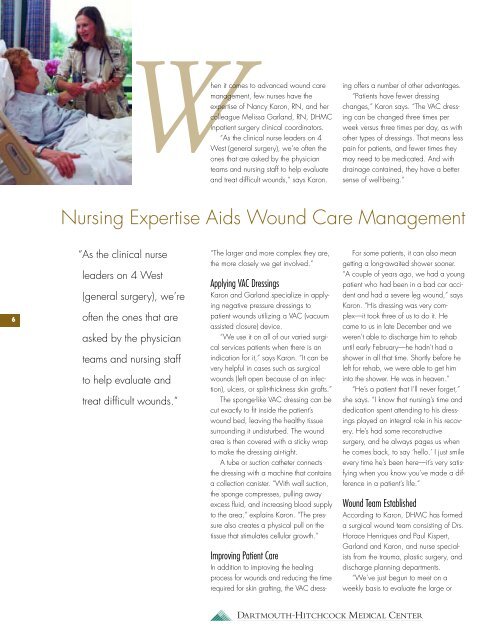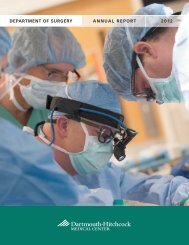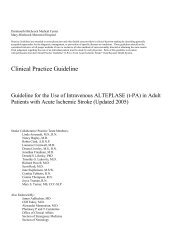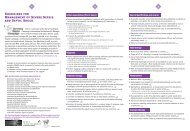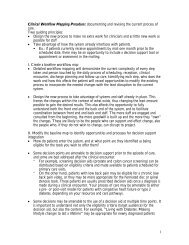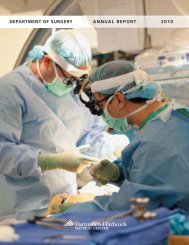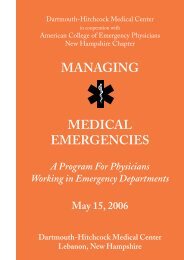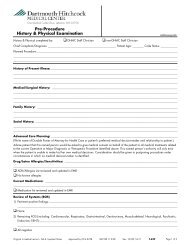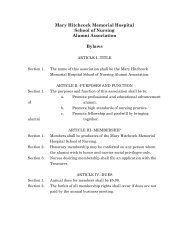Caring - Dartmouth-Hitchcock
Caring - Dartmouth-Hitchcock
Caring - Dartmouth-Hitchcock
Create successful ePaper yourself
Turn your PDF publications into a flip-book with our unique Google optimized e-Paper software.
6<br />
When it comes to advanced wound care<br />
management, few nurses have the<br />
expertise of Nancy Karon, RN, and her<br />
colleague Melissa Garland, RN, DHMC<br />
inpatient surgery clinical coordinators.<br />
“As the clinical nurse leaders on 4<br />
West (general surgery), we’re often the<br />
ones that are asked by the physician<br />
teams and nursing staff to help evaluate<br />
and treat difficult wounds,” says Karon.<br />
“The larger and more complex they are,<br />
the more closely we get involved.”<br />
Applying VAC Dressings<br />
Karon and Garland specialize in applying<br />
negative pressure dressings to<br />
patient wounds utilizing a VAC (vacuum<br />
assisted closure) device.<br />
“We use it on all of our varied surgical<br />
services patients when there is an<br />
indication for it,” says Karon. “It can be<br />
very helpful in cases such as surgical<br />
wounds (left open because of an infection),<br />
ulcers, or split-thickness skin grafts.”<br />
The sponge-like VAC dressing can be<br />
cut exactly to fit inside the patient’s<br />
wound bed, leaving the healthy tissue<br />
surrounding it undisturbed. The wound<br />
area is then covered with a sticky wrap<br />
to make the dressing air-tight.<br />
A tube or suction catheter connects<br />
the dressing with a machine that contains<br />
a collection canister. “With wall suction,<br />
the sponge compresses, pulling away<br />
excess fluid, and increasing blood supply<br />
to the area,” explains Karon. “The pressure<br />
also creates a physical pull on the<br />
tissue that stimulates cellular growth.”<br />
Improving Patient Care<br />
In addition to improving the healing<br />
process for wounds and reducing the time<br />
required for skin grafting, the VAC dress-<br />
ing offers a number of other advantages.<br />
“Patients have fewer dressing<br />
changes,” Karon says. “The VAC dressing<br />
can be changed three times per<br />
week versus three times per day, as with<br />
other types of dressings. That means less<br />
pain for patients, and fewer times they<br />
may need to be medicated. And with<br />
drainage contained, they have a better<br />
sense of well-being.”<br />
Nursing Expertise Aids Wound Care Management<br />
“As the clinical nurse<br />
leaders on 4 West<br />
(general surgery), we’re<br />
often the ones that are<br />
asked by the physician<br />
teams and nursing staff<br />
to help evaluate and<br />
treat difficult wounds.”<br />
For some patients, it can also mean<br />
getting a long-awaited shower sooner.<br />
“A couple of years ago, we had a young<br />
patient who had been in a bad car accident<br />
and had a severe leg wound,” says<br />
Karon. “His dressing was very complex—it<br />
took three of us to do it. He<br />
came to us in late December and we<br />
weren’t able to discharge him to rehab<br />
until early February—he hadn’t had a<br />
shower in all that time. Shortly before he<br />
left for rehab, we were able to get him<br />
into the shower. He was in heaven.”<br />
“He’s a patient that I’ll never forget,”<br />
she says. “I know that nursing’s time and<br />
dedication spent attending to his dressings<br />
played an integral role in his recovery.<br />
He’s had some reconstructive<br />
surgery, and he always pages us when<br />
he comes back, to say ‘hello.’ I just smile<br />
every time he’s been here—it’s very satisfying<br />
when you know you’ve made a difference<br />
in a patient’s life.”<br />
Wound Team Established<br />
According to Karon, DHMC has formed<br />
a surgical wound team consisting of Drs.<br />
Horace Henriques and Paul Kispert,<br />
Garland and Karon, and nurse specialists<br />
from the trauma, plastic surgery, and<br />
discharge planning departments.<br />
“We’ve just begun to meet on a<br />
weekly basis to evaluate the large or


